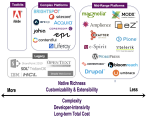Alfresco unveils a major upgrade
Today is a big day for Alfresco (and Alfresco users). This is the official launch date for Alfresco Labs 3d (Stable), which in its totality constitutes the most massive product upgrade in the company's history. (Forklift not included.) Actually, the slated date was January 19, but for various reasons (including a U.S. holiday, and yesterday's presidential inauguration, both of which take attention off "other news" -- such as product upgrades), the release was delayed until today.
As always with Alfresco, you need to separate marketing from reality. Here's our quick take.
The new Alfresco features some interesting open-source product integrations, most notably involving Joomla!, MediaWiki, Moodle, and OpenOffice.org. Alfresco has always used OO.o on the back end in headless mode as a file-format transcoder and renditioning aid, but the news this time is that OO.o users now have direct, in-product access to Alfresco repository services. For example, an OpenOffice user can navigate Alfresco spaces; search and open documents; check documents in and out; view document details; and invoke workflow events, all from toolbar buttons in the standard OO.o user interface.
Arguably the most newsworthy additions to Alfresco's already substantial catalog of capabilities involve Web content application development and page editing. To facilitate Web app development, there's now something called Alfresco Surf, which is a scripting, templating, and packaging framework for deploying Model-View-Controller apps into Alfresco. The goal is ostensibly to make is easier to develop, test, and deploy AJAX Web apps without IT intervention. I say "ostensibly" because as with all things Alfresco, Surf is painfully elaborate, encompassing a zoo of moving parts, and unless you're an experienced Web app developer there's little likelihood of your writing a non-trivial Surf app singehandedly.
To make it easier to piece together the Surf puzzle-parts, Alfresco 3d comes with something called Alfresco Web Studio, which is a drag-and-drop visual editor for end-user site development. A semi-technical user (i.e., a non-technical user with some training) can arrange drop-in components on a page and do in-context editing via pop-up forms linked to components. (The forms, notably, are role-driven as to their exact appearance and capabilities.) By default, the in-context-editing forms -- we found -- are rather homely and austere-looking. But it's better than not having them. (And again, as with all things Alfresco, you have the source code. Customize to your heart's content -- if you dare.)
Role-based visual assembly of componentized web pages is new for Alfresco -- and it's something critics (ourselves included) have long called for as a remedy for the product's relative inflexibility in the hands of non-programmers. It finally begins to bring Alfresco a modicum of feature-parity (on the front end) with commercial Java products like Percussion (Alfresco's visual page design paradigm bears a striking resemblance to Percussion's Active Assembly mechanism).
You'll find many other enhancements and feature build-outs in the new Alfresco release -- too many for us to cover here, certainly. But not too many for us to cover our Web CMS Report 2009. Subscribers will receive an update shortly. We hope you'll (ahem) watch for it.








